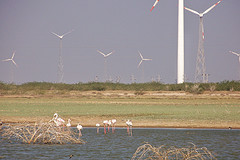6 years ago
Monday, November 16, 2015
Saturday, November 14, 2015
Save Water, Invest in Wind Energy
WATER CONSUMPTION--CONVENTIONAL POWER PLANTS
Technology gallons/kWh liters/kWh
Nuclear 0.62 2.30
Coal 0.49 1.90
Oil 0.43 1.60
Combined Cycle 0.25 0.95
Small amounts of water are used to clean wind turbine rotor blades in arid climates (where rainfall does not keep the blades clean). The purpose of blade cleaning is to eliminate dust and insect buildup, which otherwise deforms the shape of the airfoil and degrades performance.
Similarly, small amounts of water are used to clean photovoltaics (solar) panels. Water use numbers for these two technologies are as follows:
WATER CONSUMPTION--WIND AND SOLAR
Technology gallons/kWh liters/kWh
Wind [1] 0.001 0.004
Solar [2] 0.030 0.110
Wind therefore uses less than 1/600 as much water per unit of electricity produced as does nuclear, and approximately 1/500 as much as coal.
NOTES
[1] American Wind Energy Association estimate, based on data obtained in personal communication with Brian Roach, Fluidyne Corp., December 13, 1996. Assumes 250-kW turbine operating at .25 capacity factor, with blades washed four times annually.
[2] Meridian Corp., "Energy System Emissions and Materials Requirements," U.S. Department of Energy, Washington, DC. 1989, p. 23.
Technology gallons/kWh liters/kWh
Nuclear 0.62 2.30
Coal 0.49 1.90
Oil 0.43 1.60
Combined Cycle 0.25 0.95
Small amounts of water are used to clean wind turbine rotor blades in arid climates (where rainfall does not keep the blades clean). The purpose of blade cleaning is to eliminate dust and insect buildup, which otherwise deforms the shape of the airfoil and degrades performance.
Similarly, small amounts of water are used to clean photovoltaics (solar) panels. Water use numbers for these two technologies are as follows:
WATER CONSUMPTION--WIND AND SOLAR
Technology gallons/kWh liters/kWh
Wind [1] 0.001 0.004
Solar [2] 0.030 0.110
Wind therefore uses less than 1/600 as much water per unit of electricity produced as does nuclear, and approximately 1/500 as much as coal.
NOTES
[1] American Wind Energy Association estimate, based on data obtained in personal communication with Brian Roach, Fluidyne Corp., December 13, 1996. Assumes 250-kW turbine operating at .25 capacity factor, with blades washed four times annually.
[2] Meridian Corp., "Energy System Emissions and Materials Requirements," U.S. Department of Energy, Washington, DC. 1989, p. 23.
Tuesday, April 14, 2015
Sunday, March 1, 2015
Thursday, January 22, 2015
Draft Mission Document for Wind Energy
GOI ( MNRE ) has prepared a draft of mission Wind Power !
Following are the plans:-
- Generate capacity of 100 Gw of wind power by 2022.( Presently than 20 GW).
This will be an investment of over Rs 10 lakh crore. - The potential is estimated at 300 Gw.
- Extend the ‘generation based incentive for project developers for five years.( Will cosr Rs 18,000 Crore)
- This ‘wind energy mission’ will be a part of the National Action Plan for Climate Change (NAPPC).
- Finance minister Arun Jaitley is likely to announce a slew measures in his budget including a 10-year tax holiday for wind power producers, concessions in customs duty and exemption in excise duty for procurement of technology and equipment for projects.
- Budget may also announce a ‘National Offshore Wind Energy Policy’ extending further fiscal sops in the form of exemption from service tax for services like conducting wind resource assessment, environment impact assessment (EIA), oceanographic study, utilisation of survey vessels and installation of vessels for these projects.
- The Budget 2013-14 gave a set of incentives for the wind sector. It reinstated generation-based incentive (GBI) that had resulted in the growth of the sector in the past. An incentive of 50 paise is provided for every unit of electricity generated under the GBI scheme.
- The government, also reinstated accelerated depreciation (AD) for wind sector last year. The AD scheme allowed investors to write down up to 80 per cent of the project cost as depreciation when calculating taxable profits.
- The withdrawal of AD and GBI schemes in 2012 had for wind energy projects led to fall in capacity addition with a mere addition of 1,800 MW new capacity in 2012-13 as against 3,000 MW in 2011-12.
- About 7000 MW of offshore wind capacity has already been installed around the world and around the same capacity is under construction.
Subscribe to:
Posts (Atom)
.jpg)







.jpg)




